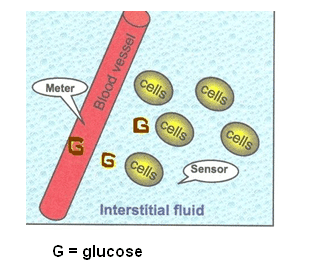Continuous blood glucose testing: How do sensors work?
 Sensors record glucose levels continuously around the clock!
Sensors record glucose levels continuously around the clock!
They allow you to see how fast and in what direction glucose levels are trending. You can also see what your sugar levels were overnight. Glucose readings are transmitted to a monitor or insulin pump where the values are displayed.
Currently there is only one on the market. It’s made by Medtronic. Others may be available in the near future.
How do they work?
A tiny glucose-sensing device called a "sensor" is inserted just under the skin (subcutaneous tissue). It's very similar to insertion of an insulin pump catheter. Sensors are typically inserted in the abdominal or upper buttock area, and tape is used to hold them in place.
The sensor measures the level of glucose in the interstitial fluid (fluid surrounding the cell) every 10 seconds and changes it into an electrical signal. The signal represents the amount of sugar in the blood. A small transmitter attaches to the sensor. It sends a signal to an insulin pump or a pager-sized device called a "monitor" that you attach to a belt or the waistline of your pants.
A small transmitter attaches to the sensor. It sends a signal to an insulin pump or a pager-sized device called a "monitor" that you attach to a belt or the waistline of your pants.
The system automatically records an average glucose value every 5 minutes for up to 72 hours.
Results of several finger stick blood glucose readings taken with your glucose meter at different times each day are entered into the monitor for calibration.
After 3 days, the sensor is removed and the information stored in the CGM is downloaded into a computer. You and your diabetes educator can then review your glucose levels in relation to the other data collected and make any necessary adjustments in your diabetes management plan. The information will be presented as graphs or charts that can help reveal patterns of glucose fluctuations.
When Is It Used?
A monitors is used to look for trends in glucose levels, like what’s happening overnight or high blood sugar levels between meals, or early morning spikes in blood sugar.
It’s not meant to replace monitoring your blood sugars with a meter though. The main advantage of continuous glucose monitoring is that it can help identify fluctuations and trends that would otherwise go unnoticed with standard A1C tests and finger stick measurements, and allow you to take action to avoid severe highs or lows.





